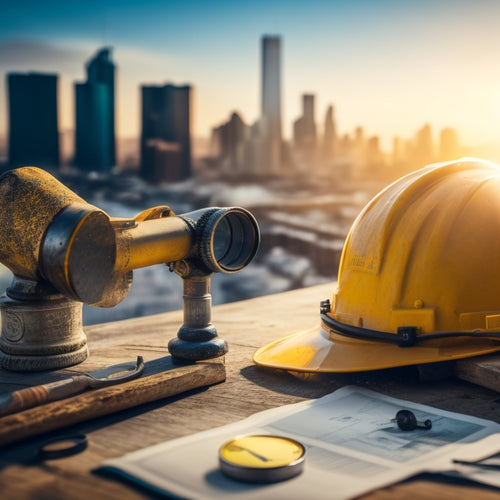
Efficient Installation Guides for Renewable Energy Systems
Share
When designing a renewable energy system, you'll want to optimize every component and process to maximize energy production, reduce costs, and guarantee safe and reliable operation. Start by evaluating your roof's orientation and conducting a shading analysis to minimize energy losses. Choose a high-efficiency inverter and optimize your wiring and electrical design to reduce energy losses. Confirm that your mounting and racking system can withstand environmental stresses, and integrate an energy storage system that's compatible with your renewable source. By following these guidelines, you'll be well on your way to a efficient and reliable renewable energy system - and that's just the beginning of your journey to maximizing your energy harvest.
Key Takeaways
• Optimize solar panel installation by evaluating roof orientation, conducting shading analysis, and positioning panels strategically for maximum energy generation.
• Select high-efficiency inverters with peak efficiency above 98% and consider durability, reliability, and MPPT efficiency for increased energy yield.
• Ensure wiring and electrical design optimization by focusing on cable management, wire sizing, and securing cables to prevent damage and overheating.
• Implement a robust mounting and racking system that can withstand environmental stresses, and verify compliance with local regulations.
• Integrate energy storage systems that are compatible with the renewable source, and accurately size them based on energy demands and climate conditions.
Optimizing Roof Space for Solar
When planning to install a solar panel system, you'll typically want to maximize your roof's energy-generating potential by optimizing its space for solar. This involves evaluating your roof's orientation, as it has a substantial impact on energy production. Ideally, a south-facing roof with an angle between 30° to 40° is best for solar panels. However, if your roof doesn't meet these conditions, you can still achieve efficient energy generation with proper planning.
A thorough shading analysis is essential to identify areas that receive partial or full shade, which can greatly reduce energy production. Obstacles like trees, chimneys, and neighboring buildings can cast shadows on your roof, affecting solar panel performance. By conducting a shading analysis, you can strategically position your solar panels to minimize energy losses. This might involve pruning trees, relocating vents, or adjusting panel placement to ensure maximum energy generation.
Choosing the Right Inverter Type
As you navigate the world of renewable energy systems, choosing the right inverter type is essential for top performance.
You'll need to take into account factors like inverter efficiency ratings, which can greatly impact your system's overall energy yield.
Inverter Efficiency Ratings
You'll want to prioritize inverter efficiency ratings when selecting the right inverter type for your renewable energy system, since even a 1% difference in efficiency can greatly impact your system's overall performance. A high-efficiency inverter can greatly reduce energy losses, resulting in increased energy yield and a faster return on investment. When evaluating inverter efficiency, consider the following key factors:
-
Inverter Durability: Look for inverters with a proven track record of reliability and durability, ensuring minimal downtime and maintenance.
-
Inverter Reliability: Assess the inverter's ability to operate within its specified parameters, even in varying environmental conditions.
-
Peak Efficiency: Choose inverters with high peak efficiency ratings, typically above 98%, to minimize energy losses.
- MPPT Efficiency: Consider inverters with high maximum power point tracking (MPPT) efficiency, ensuring excellent energy harvesting.
String Inverter Options
With high-efficiency inverters in mind, selecting the right inverter type is essential for optimizing your renewable energy system's performance, and string inverters are a popular option worth exploring.
As you contemplate string inverters, it's vital to prioritize inverter sizing, making sure that your system can handle the maximum power output of your solar panels or wind turbines. Proper inverter sizing will prevent energy losses, reducing the risk of overheating and increasing your system's overall efficiency.
When choosing a string inverter, you'll want to take into account inverter redundancy to guarantee continuous operation in case of component failure. This redundancy can be achieved through the installation of multiple, smaller inverters or a single, larger inverter with built-in redundancy features.
Microinverter Advantages
Microinverters offer a unique set of benefits that make them an attractive option for renewable energy systems, particularly when it comes to maximizing energy harvest and ensuring peak system performance. As you consider your inverter type, you'll want to weigh the advantages of microinverters against other options.
Here are some key benefits to keep in mind:
-
Individual panel optimization: Microinverters allow each panel to operate independently, ensuring that if one panel is shaded or underperforming, it won't affect the rest of the system.
-
Increased energy yield: By optimizing energy harvest at the panel level, microinverters can increase your system's overall energy production.
-
Grid resilience: Microinverters can provide grid support functions, enhancing grid stability and resilience in the face of changing energy demand.
- Cost effectiveness: Microinverters can reduce installation costs by eliminating the need for a central inverter and related infrastructure.
Efficient Wiring and Electrical Design
When designing an electrical system for renewable energy, a well-planned wiring layout is vital to minimize energy losses and guarantee peak system performance. As you design your system, it's important to take into account the significance of efficient wiring and electrical design.
You'll want to make sure that your wiring layout is optimized for maximum energy harvesting and minimal energy loss.
To achieve this, you'll need to focus on two critical aspects: cable management and wire sizing. Effective cable management involves organizing and securing cables to prevent damage, overheating, and electrical interference. This can be achieved through the use of cable ties, cable trays, and conduit systems.
Meanwhile, wire sizing is essential to ensure that your wires can handle the maximum power output of your renewable energy system. Undersized wires can lead to energy losses, overheating, and even electrical fires.
Proper Mounting and Racking Systems
You'll need to carefully select and install a proper mounting and racking system to guarantee your renewable energy system operates at peak performance and withstands environmental stresses. A well-designed mounting and racking system safeguards the structural integrity of your system, enabling it to withstand various environmental conditions such as wind, snow, and seismic activity.
When selecting a mounting and racking system, consider the following key factors:
-
Load calculations: Accurately calculate the weight and stress of your renewable energy system to make certain the mounting and racking system can support it.
-
Environmental factors: Consider the environmental conditions of your installation site, including wind, snow, and seismic activity, to ensure the mounting and racking system can withstand them.
-
Structural integrity: Ensure the mounting and racking system is designed to maintain the structural integrity of your renewable energy system, even in extreme environmental conditions.
- Compliance with local regulations: Verify that the mounting and racking system complies with local building codes and regulations.
Energy Storage System Integration
When integrating energy storage systems into your renewable energy setup, you'll need to carefully think about the system design.
You'll want to make sure that your energy storage system is compatible with your renewable energy source, taking into account factors like voltage, current, and power output.
System Design Considerations
To guarantee a reliable and efficient renewable energy system, you must carefully contemplate the system design, particularly when integrating an energy storage system (ESS), as it plays a critical role in stabilizing the grid and optimizing energy usage.
When designing your system, it's crucial to ponder the following key factors:
-
Load Calculations: Accurately determine the energy demands of your building or facility to make certain the ESS is sized correctly.
-
Climate Analysis: Assess the local climate and weather patterns to optimize the system's performance and energy harvesting capabilities.
-
System Sizing: Properly size the renewable energy system and ESS to meet your energy demands and maintain a stable grid.
- Grid Connection: Ensure a seamless connection to the grid, taking into consideration voltage, frequency, and power quality requirements.
Battery Compatibility Checks
During the integration of an energy storage system (ESS), it's essential that you confirm the compatibility of the battery with the renewable energy system to guarantee smooth operation and peak performance.
As you select a battery for your ESS, make sure it meets the system's power and energy requirements. You'll want to check the battery's voltage, current, and capacity ratings to ensure they align with your system's specifications.
Battery life cycles are also a vital consideration. You'll want to choose a battery with a sufficient number of charge and discharge cycles to meet your energy storage needs.
Look for manufacturer certifications, such as UL or IEC, which guarantee the battery meets industry standards for performance and safety. Additionally, consider the battery's operating temperature range, as this can impact its overall performance and lifespan.
Building Code Compliance Essentials
Adherence with local building codes and regulations is essential to guaranteeing your renewable energy system installation meets safety and performance standards. As you navigate the installation process, it's vital to stay up-to-date with the latest code revisions and permitting challenges.
Failing to comply with local regulations can lead to costly rework, project delays, and even system shutdowns.
To guarantee a smooth installation process, keep the following essentials in mind:
-
Review local building codes: Familiarize yourself with local building codes, ordinances, and regulations to identify specific requirements for renewable energy systems.
-
Obtain necessary permits: Secure all necessary permits and approvals before commencing the installation to avoid potential setbacks.
-
Comply with electrical and fire safety codes: Ensure your installation meets electrical and fire safety codes to prevent hazards and ensure safe operation.
- Document compliance: Maintain detailed records of your compliance with local building codes and regulations to facilitate inspections and audits.
Performance Monitoring and Analysis
You'll need to track your renewable energy system's performance over time to make sure it's operating at peak levels, which is where performance monitoring and analysis come in. This important step guarantees your system is running efficiently and effectively, maximizing your return on investment.
By monitoring your system's performance, you'll be able to identify areas for improvement, detect potential issues before they become major problems, and optimize energy production.
Data analytics plays a significant role in performance monitoring and analysis. By collecting and analyzing data on your system's performance, you can pinpoint trends, patterns, and anomalies. This enables you to make data-driven decisions to optimize your system's performance, reducing downtime and increasing energy output.
System optimization is key to achieving maximum efficiency and ROI. By leveraging data analytics and performance monitoring, you'll be able to fine-tune your system, ensuring it operates at peak levels and providing a strong foundation for your renewable energy investment.
Safety Precautions and Quality Control
Implementing safety precautions and quality control measures is essential to preventing accidents, reducing downtime, and guaranteeing your renewable energy system operates reliably and efficiently. As you install and maintain your system, it's important to prioritize safety and quality to avoid costly mistakes and ensure a successful project.
To guarantee a safe and successful installation, consider the following essential measures:
-
Conduct a thorough Hazard Assessment to identify potential risks and develop strategies to mitigate them.
-
Wear Personal Protective Equipment (PPE), such as hard hats, gloves, and safety glasses, to protect yourself from physical harm.
-
Develop a quality control checklist to verify that each component is installed correctly and meets industry standards.
- Perform regular inspections and maintenance to detect and rectify potential issues before they become major problems.
Frequently Asked Questions
Can I Install a Renewable Energy System Myself?
'You're contemplating a DIY renewable energy system, but be mindful that taking it on by yourself can present significant DIY challenges and Safety precautions, so make sure you're well-equipped to handle the complexities and risks involved.'
How Long Does a Typical Installation Project Take?
When planning your renewable energy installation, you'll want to know that a typical project timeline ranges from a few days to several weeks, depending on the system's complexity, labor costs, and your site's accessibility.
Are Renewable Energy Systems Covered by Warranties?
You'll be relieved to know that most renewable energy systems come with warranties, covering manufacturing defects and performance guarantees. However, it's important to understand the manufacturer's obligations and policy limitations to make sure you're protected.
Can I Expand My System in the Future if Needed?
You can easily scale up your system as energy needs grow, thanks to its modular design, allowing for seamless future upgrades, ensuring your investment remains adaptable and efficient, and giving you peace of mind.
Do Renewable Energy Systems Increase Property Value?
As you consider investing in renewable energy, you'll be pleased to know that it can greatly enhance your property value, offering appraisal benefits and a resale advantage, making your home more attractive to potential buyers.
Related Posts
-

What You Need to Know About Permits and Inspections
You need to navigate the complex landscape of permits and inspections to guarantee your project complies with local z...
-

What You Need to Know About RV Solar Maintenance
When you're out on the road, your RV's solar panel system is your lifeline. But without regular maintenance, you're l...
-

Safety First: Why Seniors Need Advanced Vehicle Features
As you get behind the wheel, you're likely unaware that seniors are 16% more likely to be involved in a fatal car cra...


